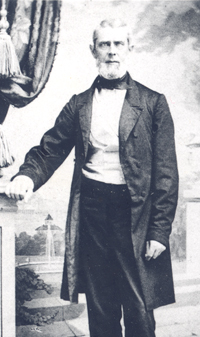Frederick Ernst Baumgarten (1810-1869)
Frederick Baumgarten was born in 1810 in Nordheim, in the kingdom of Hanover, one of the then independent states of northern Germany. Before emigrating, his full given name was spelled in the German manner, Friedrich Ernst. He studied medicine at the University of Göttingen and passed his examinations in surgery in 1831. His first position was as a mining surgeon in Clausthal (now Clausthal-Zellerfeld), in the Harz Mountains north of Göttingen, where there were extensive deposits of silver and iron, and the constant threat of accidents in the mines. Baumgarten married the former Louise Beckmann of Nordheim; the couple had a son, Gustav, and two daughters, Joanna and Theodora. Baumgarten also studied at the University of Jena, in neighboring principality of Thuringia, receiving a degree in 1844. He was active in regional surgical societies, published in his field, and edited a journal. Several examples of his early work are part of the Baumgarten family papers.
Like many progressive Germans of his time, Baumgarten was intrigued by prospects of a freer life in the United States. Leaving family behind, he sailed to Galveston, Texas, in 1846 and attempted to establish his practice there. But yellow fever epidemics in on the Texas coast discouraged this plan. Baumgarten traveled north to St. Louis in 1850, which he found more to his liking. He sent for his family: they made the journey via New Orleans, arriving in January 1851. St. Louis was already home to a burgeoning German immigrant community and Baumgarten was soon able to build a successful practice. He became an American citizen in 1852. His wife Louise, however, could not happily adjust to the new home and returned with their daughters to live in Nordheim. Gustav remained with his father and was enrolled in a private school.
Baumgarten enjoyed a successful career in St. Louis. He replaced his previous special interest in mining accidents with emphasis on obstetrics, but like most physicians of his time took patients of all sorts. He was a founding member of the German Medical Society of St. Louis and was early associated with the St. Louis Medical Society and the St. Louis Academy of Science. He renewed ties with the Masonic Order, which he had entered as a young man in Germany. A variety of documents in the Baumgarten family papers attest to his deliberate steps in Americanizing his personal life and career. He had linguistic and literary interests as well, said to have gone so far as to translate American poetry into German for the benefit of fellow immigrants – although these efforts do not survive.
Baumgarten visited his native Germany at least once in 1864, but there is no indication whether or not he attempted to see his estranged wife and daughters on that journey. He returned to his American home and the many and varied interests and investments he made in St. Louis and surrounding rural counties. He doubtless took satisfaction in the fact that Gustav followed in his footsteps personally and professionally. Baumgarten died from injuries suffered in a riding accident in 1869. Colleagues memorialized him as “a man who was in many respects a model physician. He was an example to those younger than himself, . . . a beloved companion and fellow counselor.”

Related Resources:
Back to Biographies

